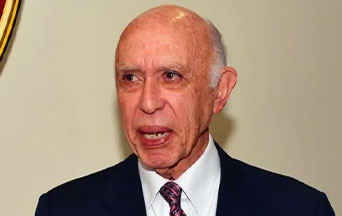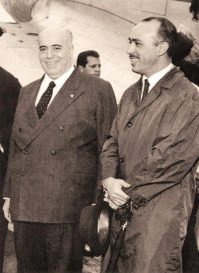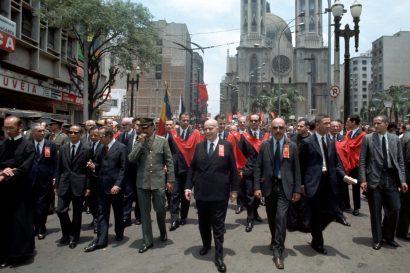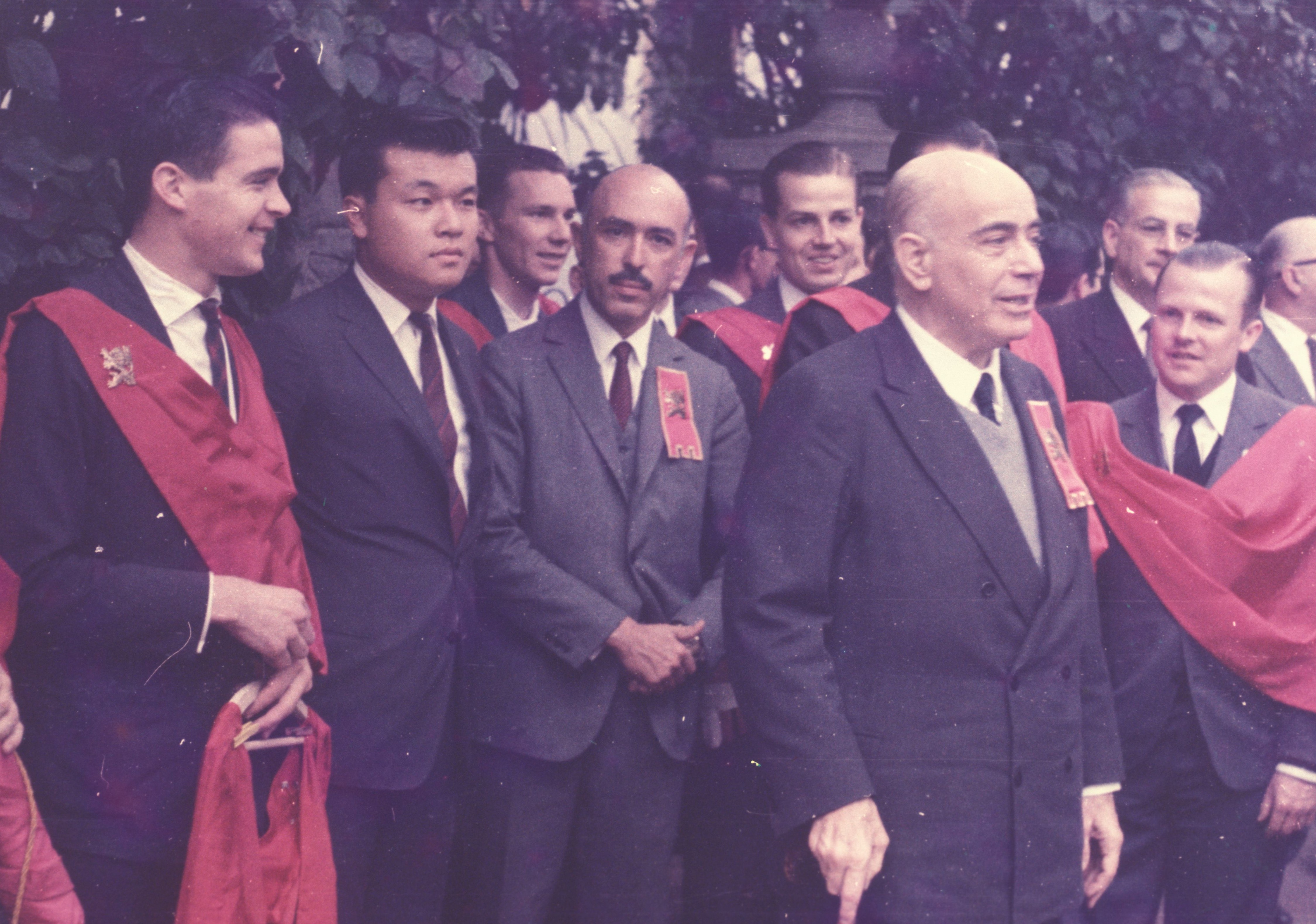
Brazilian newspapers have prominently remembered the figure of Adolpho Lindenberg, who passed away at the age of ninety-nine on May 2, 2024. The press presented him as a world-famous architect, pointing out that he passed away in the year in which CAL (Constructora Adolpho Lindenberg), the company he created, celebrated seventy years of life.
Born on June 3, 1924, to a distinguished family of German origin and graduated in Engineering and Architecture from Mackenzie University, Lindenberg began his professional career in São Paulo, Brazil, in 1954. Since then, he has carried out more than 700 projects, mainly in the Brazilian metropolis where, as Marcelo Buazar, one of the company’s current four partners, recalls, he had as many as 100 simultaneous construction sites. The Folha de Sao Paulo of May 3 called him “an icon of the real estate market and a diffuser of the neoclassical style in São Paulo.”
Lindenberg was the only Brazilian architect of the twentieth century to achieve international prominence without embracing architectural modernism. The years in which he was born were those of the revolution in architecture, of which Oscar Niemeyer, the communist architect who would design Brasilia, would be a symbol. At the same time, Le Corbusier would become the ideal of the new architects of Latin America.
 Learn All About the Prophecies of Our Lady of Good Success About Our Times
Learn All About the Prophecies of Our Lady of Good Success About Our Times
Moving against the trend, in the sixties, seventies and eighties of the twentieth century, Eng. Lindenberg built buildings in the neoclassical or Mediterranean style, gaining great acceptance in the market, so much so that 60% of the luxury buildings of the time in São Paulo were designed according to the lines dictated by him. “Because of his influence on the architecture of São Paulo, his neoclassical style has been called the ‘Lindenberg style’ to demonstrate how he left his mark on the history of national architecture as the creator of a real estate brand” (Noticias UOL, May 3, 2024).
The Brazilian mass media considered the fact that Adolpho Lindenberg was also a prominent representative of the Tradition, Family and Property Association to be a secondary element. In reality, Lindenbeg’s entire life was the expression of an intellectual commitment that he carried out since he was a boy, alongside his more illustrious cousin, Prof. Plinio Corrêa de Oliveira, to whom he dedicated a precious book of memories titled Meu primo Plinio Corrêa de Oliveira—Aportes biográficos (São Paulo: Artpress, 2016).

Adolpho and Plinio were educated in the house of their grandmother Gabriela Ribeiro dos Santos, a grande dame who, in the 1930s, exerted a profound influence on São Paulo society. Grandma Gabriella demanded that all her five children, accompanied by their families, visit her every day, so that the cousins grew up practically as if they were siblings.
Devotion to the Immaculate Heart of Mary Is so Crucial for Our Days
Plinio and Adolpho were the sons of two sisters, Lucilia and Eponina. When Plinio was twenty years old, Adolpho was seven or eight years old. Still, he was already fascinated by his cousin’s personality and admired the courage and clarity with which he faced family discussions at the Ribeiro dos Santos house. “Monarchist, enthusiastic about the Ancien Régime, opposed to extravagant fashions, an immature critic of contemporary art as well as of Hollywood influence, distrustful of a certain industrialism. You can well imagine the lively controversies at Grandma Gabriella’s house, especially with her aunts and uncles imbued with positivism and admiration for the modern world!”
The urban transformation of the city of São Paulo reflected a profound cultural battle. Plinio Corrêa de Oliveira had just left university when, in the elections for the Constitutional Convention in May 1933, he was, at the age of 24, the most-voted congressman in all of Brazil. In August of the same year, he was called to take over the directorship of Legionário, the unofficial newspaper of the Archdiocese of São Paulo, which in a few years became the most influential Catholic weekly in Brazil.

Dr. Plinio, as he was affectionately called, summed up his life in these words: “When still very young, I marveled at the ruins of Christendom and gave them my heart. I turned my back on all I could expect, and made of that past, so full of blessings, my future!”
Eternal and Natural Law: The Foundation of Morals and Law
Did Adolpho Lindenberg fully understand the radical nature of his cousin’s vocation? What is certain is that he manifested a feudal loyalty to his person. In 1943, the publication of the book Em Defesa de Ação Catolica led to the ostracism of Plinio Corrêa de Oliveira, then president of Catholic Action in São Paulo, for daring to refute the progressive errors creeping through Catholic circles.
Legionário continued its testimony for a few more years. Adolpho was the youngest of the group, who met every night in a small apartment on Rua Martim Francisco, analyzing, under the guidance of Dr. Plinio, the deteriorating religious and political situation in Brazil and the world.
The young architect followed his cousin into the Marian Congregations. Under his guidance, he became one of the editors of the monthly magazine Catolicismo and was at his side when, in 1960, the TFP was founded, which from Brazil radiated throughout the world. The great Brazilian thinker and man of action died on October 3, 1995, but Adolpho Lindenberg confirmed his loyalty to him by assuming the presidency of the Plinio Corrêa de Oliveira Institute, created in 2006, to continue his work.
Adolpho Lindenberg believed that he could reconcile his counter-revolutionary commitment with a professional activity that turned out to be successful. Perhaps Divine Providence bountifully helped him, so that he could help others just as munificently. Generosity was a hallmark of his personality. He did not limit his aid to the TFPs of Brazil and other countries of the world, but he understood how minimizing it was to confine the thought and work of Plinio Corrêa de Oliveira to the schemes of a group. Thus, he supported with superiority of spirit any initiative that seemed to him to favor the Counter-Revolution of the world.
Revolution and Counter-Revolution

Until shortly before his death, Dr. Lindenberg animated lofty discussions in his apartment about the religious and political crisis of our time. He had his own originality of thought, which he expressed in the book The Free Market in a Christian Society, translated into Italian in 2000. We must not confuse the liberal ideology, which stems from the revolutionary trilogy of Liberty, Equality, Fraternity, with the defense of the freedom that man must enjoy in his economic activities. The four main points of agreement between Catholic thought and economic freedom are, for Lindenberg, the defense of the right to property and private initiative; the limitation of the role of the state in the socio-economic order; opposition to systematic egalitarian reforms; opposition to any legislative proposal of a confiscatory nature.
Science Confirms: Angels Took the House of Our Lady of Nazareth to Loreto
In the second part of the book, the author describes the outlines of an authentically Christian social order founded on the principle of subsidiarity and the harmonious collaboration of intermediate bodies. This ideal society was called the “Reign of Mary” by Saint Louis Marie Grignon de Montfort. He learned to desire ardently in the school of Dr. Plinio: an austere, hierarchical society, sacred in its foundations, that perfectly implemented the doctrine and spirit of the Church. The death of Adolpho Lindenberg marks the end of a historical era, but it pushes Counter-revolutionaries around the world to renew their commitment to the restoration of Christian society. He recalled how his cousin Plinio often used the German expression vorwätz, meaning “forward!” What Adolpho Lindenberg said about Dr. Plinio, we can repeat today in his memory: “If he were here, I am sure he would say, in the voice of one who calls for a crusade: ‘Let us look to the future, let us trust in Our Lady, and we will want it!’”
As seen on Corrispondenza Romana.
Updated May 10, 2024.

